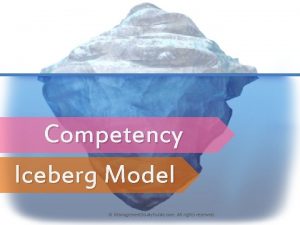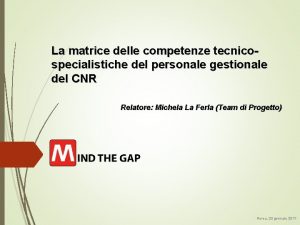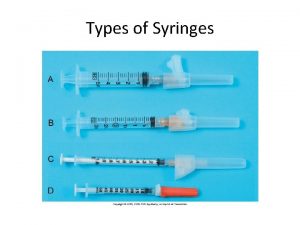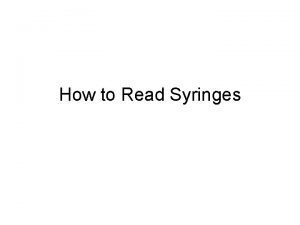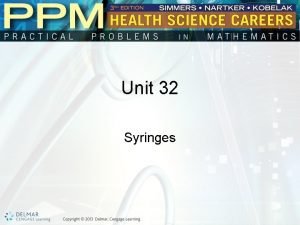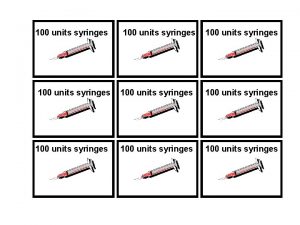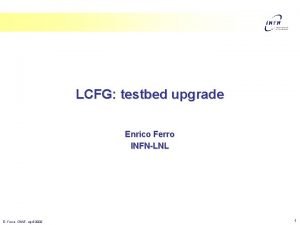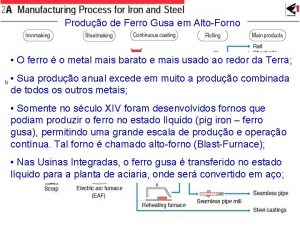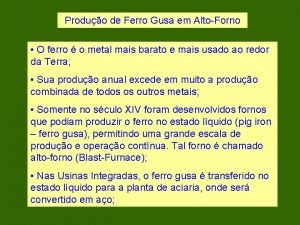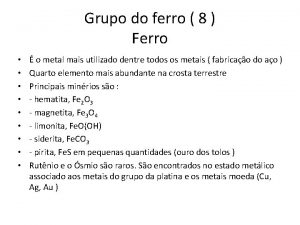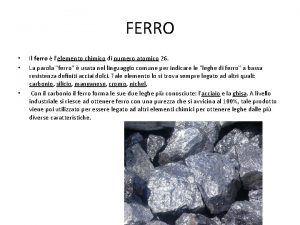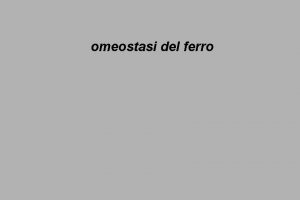Syringes Spencer Ferro My scientific apparatus that I











- Slides: 11

Syringes Spencer Ferro

• My scientific apparatus that I chose is the syringe. Syringes are used to administer vaccines directly into the muscle or under the skin. They can also be used to extract liquid from the body. Or they can be used to administer medicine to pets orally.

• They usually consist of a plastic tube with graduated markings on the side so as to be able to measure the amount of medicine you are administering to a patient. There is a plunger in the back that moves freely but snug within the body which creates positive/negative pressure either filling the syringe up or pushing the liquid in the syringe out.

• They used to make the bodies out of glass, brass, or ivory with interchangeable needle tips, though today we only see plastic, nonreusable hypodermic needs. This stops the spread of blood borne pathogens such as HIV or hepatitis.

• The syringe has come a long way since first being discovered in Roman times during the 1 st century AD. Aulus Cornelius Celsus has a writing titled De Medicina which recounts the use of syringes for medical applications. Most likely were not needle tips, but used for extracting or administering medicine in difficult to reach areas.

• Moving down the timeline a bit during the 9 th century AD, an Iraqi surgeon would use a hollow glass tube and plunger to suck the cataracts out of eyes, a practice that stuck around until the early 13 th century.

In 1844 an Irishman invented the first hollow needle to deliver vaccinations under the skin, rather than topical use. Nine years later, Alexander Wood, who had helped invent the medical hypodermic needle, started to inject morphine to treat neuralgia, which can cause extreme pain in the face. He and his wife later became addicted to the powerful drug and unfortunately his wife was the first person to ever die from an intravenous drug overdose.

• In 1956 a New Zealand pharmacist patents the all plastic, disposable syringes, eliminating the need for sterilization.

• An artist that uses this scientific apparatus as part of his work regularly is JOP, an American borosilicate flame worker. His older work consisted of giant glass syringes that were to symbolize the epidemic of drug abuse, specifically heroin and other intravenous drugs, which have been running rampant in our society today. Another artist that uses syringes in his work is Andy Paiko.

• Now we see syringes everywhere, they have had a major impact on our health and life span. Before needles were large, painful, and you could only hope that they were clean. Today the standard is disposable plastic needles which are one time use only as to completely stop the spread of diseases and needles so thin you can barely feel them penetrate the skin.

• http: //www. exchangesupplies. org/article_history_of_inject ing_and_development_of_the_syringe. php • https: //health. adelaide. edu. au/surgery/society/A%20 histor y%20 of%20 syringes. pdf • http: //en. wikipedia. org/wiki/Syringe • http: //www. milestonescientific. com/about_history. html • http: //www. sciencemuseum. org. uk/broughttolife/techniqu es/hypodermicsyringe. aspx • http: //www. diabetesexplained. com/syringe-history. html • http: //inventors. about. com/library/inventors/blsyringe. ht m • http: //www. doctorsreview. com/history/needle-trade/ • http: //www. madehow. com/Volume-3/Syringe. html • http: //www. angelfire. com/ny 5/umei/history. html
 Iceberg della competenza
Iceberg della competenza Iceberg model of competency with example
Iceberg model of competency with example Modello iceberg di spencer e spencer
Modello iceberg di spencer e spencer Modello iceberg di spencer e spencer
Modello iceberg di spencer e spencer Spencer and spencer
Spencer and spencer Spencer and spencer 1993
Spencer and spencer 1993 Injection syringe parts
Injection syringe parts Reading syringes
Reading syringes Reading syringes
Reading syringes Sau thất bại ở hồ điển triệt
Sau thất bại ở hồ điển triệt Thơ thất ngôn tứ tuyệt đường luật
Thơ thất ngôn tứ tuyệt đường luật Hãy nói thật ít để làm được nhiều
Hãy nói thật ít để làm được nhiều

